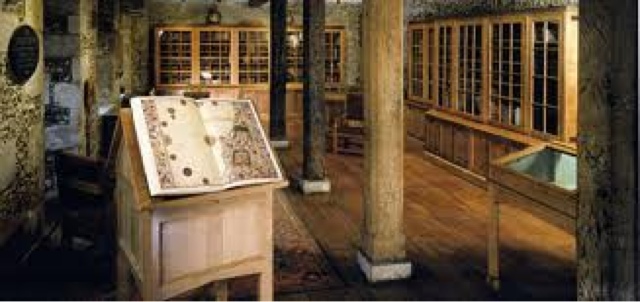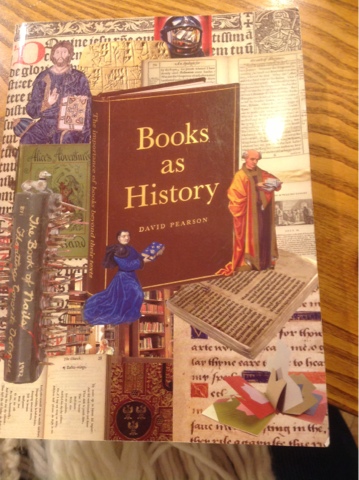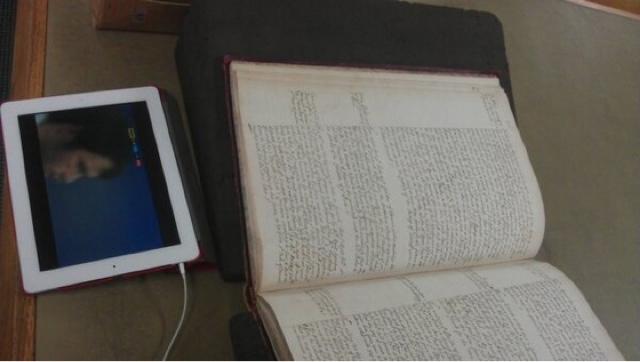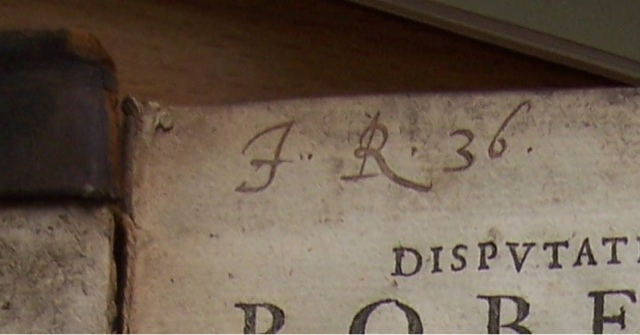This Friday, 21 June 2013, the 'World is Our House' symposium took place in the beautiful College Hall, Hereford Cathedral, followed by an evening concert in the nearby St Francis Xavier's RC Church, Broad Street, Hereford.
The title of the conference. 'the World is Our House' was chosen to embrace the core concept of the Society of Jesus that God is everywhere and can be served in every way, without the restrictions of a more traditional monastic way of life. One aim of the conference was to demonstrate how cohesive and connected every element of the Jesuit way of being is, even something as seemingly localised as the Cwm library is part of a bigger international tapestry. The phrase was used by Jerome Nadal SJ (1507-1580), an extremely important and influential early member of the Society of Jesus, who played a huge role in the success and growth of the Society.
 |
| Jerome Nadal, SJ (1507-1580) |
The 'World is Our House' conference was a huge success - a sell out crowd of some 85 delegates from a huge variety of organisations and institutions attended to hear the six papers, as well as view the three exhibitions of Peter Leech's rare books and other items of Jesuitica, a display of some of the key inscriptions and texts from the Cwm Jesuit Library at Hereford Cathedral (pictured) and the beautiful embroidered 17th century chalice veils made by Helena Wintour and Mary Bodenham, which are on loan to Hereford Cathedral until the end of August.
 |
| Cwm books on display in Hereford Cathedral Library & Archives Reading Room |
The conference was opened by Canon Chris Pullin and Professor Maurice Whitehead, both of whom spoke of their individual experiences and connections with the Cwm Jesuit Library Project. The opening comments also set the aim of the day, which was to set the seventeenth century Cwm Jesuit Library in an international context, and to draw links between the Cwm library and the wider international Jesuit ideas, ideals and culture.
The morning papers were focused on setting the scene, and introducing the Jesuits as an active and varied organisation in many areas of 17th century culture. Papers included the Jesuits and Art, 1540-1700 (Professor Peter Davidson, University of Aberdeen), the Jesuits and Science, 1540-1700 (Dr Adam Mosley, Swansea University) and the Jesuits and Music, 1540-1750 (Dr Peter Leech, Swansea University). All three papers were very well received, prompting a stimulating discussion and many interesting questions.
Over lunch time, delegates had the chance to view the three exhibitions, as well as the Hereford Mappa Mundi and Chained Library exhibition.
After lunch, the focus of the afternoon papers shifted to a regional perspective, with papers specifically discussing the Jesuits in England and Wales, 1580-1700 (Reverend Dr Thomas McCoog, SJ, Fordham University, New York and Archivist of the British Province of the Society of Jesus, London) and Helena Wintour and Jesuit vestment-making in 17th century Worcestershire (Janet Graffius, Curator of Special Collections, Stonyhurst College).
The final paper of the day was an overview of the Cwm Jesuit Library Project at Hereford Cathedral (Hannah Thomas, Swansea University), presenting delegates with the story of the project so far: discoveries made, key inscriptions identified and analysed, big research questions currently still unanswered and next steps that the project is going to take. Hannah's paper will be published in part in the next few blog posts, so keep an eye out for that! I would also be delighted if other delegates would like to contribute their own feedback and reviews of the day to the project blog at worldisourhouse.blogspot.com
After lots of interesting questions and discussion, and ways to further enhance the project, the symposium part of the day was drawn to a close. Both Canon Chris Pullin and Maurice Whitehead gave thanks for the hard work of the Hereford Cathedral staff and volunteers who had made the day possible, as well as the generous sponsorship of the Jesuit Institute in London, the British Province of the Society of Jesus and an anonymous donor, who made the whole day possible.
Delegates were given the opportunity to attend the exhibitions once more, which remained open until 5.15, and also to attend Choral Evensong in Hereford Cathedral, which featured specially chose unaccompanied 17th century music.
Finally, the day was rounded up with a fantastic concert of music associated with Jesuit Colleges in the early modern era, 1600-1750. Performed by Cappella Fede under the direction of Dr Peter Leech, the evening featured a range of musical pieces by William Byrd, Matthew Locke, Marc-Antoine Charpentier and others, and included the first modern performances of some recent archival discoveries that have not been heard since the 17th century. The concert took place at the nearby St Francis Xavier's RC Church, Hereford: the institutional successor of the Cwm as the headquarters of the College of St Francis Xavier, or the Welsh District, and therefore a fitting end to a fabulous day.

.jpg)














